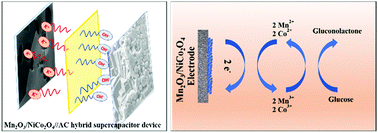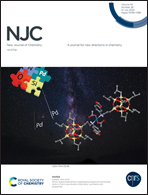Supercapacitor and non-enzymatic biosensor application of an Mn2O3/NiCo2O4 composite material†
Abstract
An efficient way to enhance the energy density of a supercapacitor device is to improve the electrochemical activity of the anode and cathode materials. The electrochemical performance of the NiCo2O4 metal oxide is enhanced by assembling a composite with Mn2O3. Herein, a Mn2O3/NiCo2O4 composite material was synthesized via a one-step in situ hydrothermal method, and the electrochemical and electrocatalytic behaviours were studied. The Mn2O3/NiCo2O4 battery-type electrode material exhibited a maximum specific capacity value of 824 C g−1 at a current density of 1 A g−1 and a superior cyclic stability (85%), making it a suitable anode material for supercapacitor application. A Mn2O3/NiCo2O4//AC asymmetric device exhibited maximum energy density and power density values of 48.6 W h kg−1 and 6.4 kW kg−1, respectively. The superior electrochemical performance of the Mn2O3/NiCo2O4 composite material inspired us to apply it as an electrocatalyst for glucose sensing. The limit of glucose detection and the linear range of the Mn2O3/NiCo2O4 electrocatalytic material were 35 μM and 0.01–15 mM, respectively.



 Please wait while we load your content...
Please wait while we load your content...